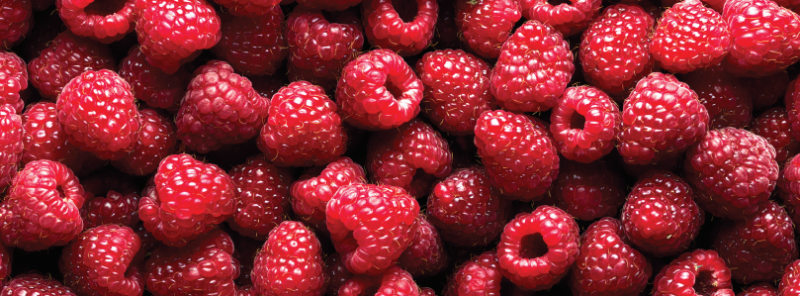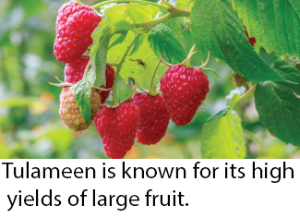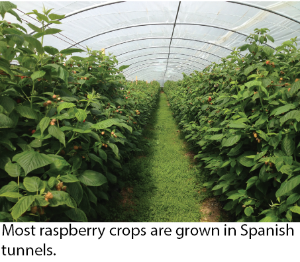Fresh Raspberry Production

Fresh Raspberry Production (PDF)
Homegrown is best
 Fresh raspberries are one of Ireland’s most popular soft fruit crops. The crop is worth an estimated €4m per annum. A good proportion of strawberry growers also grow some raspberry crops. This suits some customers’ demand for a range of soft fruits to be supplied. The most popular raspberry varieties grown are Tulameen and Glen Ample. Tulameen was bred in Canada (British Columbia). It is known for its high yields of large fruit. Glen Ample is a Scottish variety and was bred by the James Hutton Institute. It is also known for its excellent yields and large conical fruit. The vast majority of fresh raspberries are now grown under protective cropping, mostly in Spanish tunnels. The main advantage of protective cropping is that it allows for the supply of fruit outside of the traditional short summer season. Today, raspberries are supplied from late May right up until October. Fruit quality is also much higher when grown under protective cropping. This is mainly due to a much better growing environment for the crop. The cover also allows the fruit to be harvested in unfavourable weather, making production planning much more efficient. Fruit pickers also have a much more comfortable environment to work in, no matter the weather.
Fresh raspberries are one of Ireland’s most popular soft fruit crops. The crop is worth an estimated €4m per annum. A good proportion of strawberry growers also grow some raspberry crops. This suits some customers’ demand for a range of soft fruits to be supplied. The most popular raspberry varieties grown are Tulameen and Glen Ample. Tulameen was bred in Canada (British Columbia). It is known for its high yields of large fruit. Glen Ample is a Scottish variety and was bred by the James Hutton Institute. It is also known for its excellent yields and large conical fruit. The vast majority of fresh raspberries are now grown under protective cropping, mostly in Spanish tunnels. The main advantage of protective cropping is that it allows for the supply of fruit outside of the traditional short summer season. Today, raspberries are supplied from late May right up until October. Fruit quality is also much higher when grown under protective cropping. This is mainly due to a much better growing environment for the crop. The cover also allows the fruit to be harvested in unfavourable weather, making production planning much more efficient. Fruit pickers also have a much more comfortable environment to work in, no matter the weather.
Grants, schemes available
 Any project undertaken may be eligible for a capital grant of up to 40% of costs (50% for those aged under 35) from the Department of Agriculture, Food and the Marine (DAFM). This scheme is competitively based and is for new capital investments in the commercial horticulture sector only.Any project undertaken.
Any project undertaken may be eligible for a capital grant of up to 40% of costs (50% for those aged under 35) from the Department of Agriculture, Food and the Marine (DAFM). This scheme is competitively based and is for new capital investments in the commercial horticulture sector only.Any project undertaken.
Benefits
– Raspberries can be grown for local supply in almost any part of the country
– Customers have a preference for locally grown produce
– Provides local employment
– Provides an excellent income – can supplement an existing job, as most of the work is seasonal
– Is very environmentally sustainable
Facts and figures
- Excellent opportunities for new entrants to supply the local market
- The crop is valued at an estimated €4m per year
- The vast majority of raspberries are sold and consumed in Ireland
- Protected cropping is the mainstay
- Season now runs up to seven months
- Raspberries are seen as healthy and nutritious by the consumer
- Growing methods are very advanced in terms of sustainable farming
Modern production of raspberries

The vast majority of growers now plant longcane raspberry canes, which are purchased from specialist plant propagators. These are one-year-old canes with differentiated flower initials. They are usually produced to a height of about 1.5m. The canes are usually lifted from the propagation field in late November. They are then put into cold storage at subzero temperatures until required by the fruit grower. The raspberry canes are subsequently grown in substrates in pots or containers. The use of pots and containers allows growers to grow high-quality raspberries almost anywhere in the country. The pots or containers are placed on raised beds, with the crop growth
supported by a trellis system.
The use of pots and containers has also given growers the flexibility to take one crop from each newly planted raspberry cane per year. At the end of the season, the old crop is
discarded and a new crop can be replanted. This system greatly improves the productivity on the farm by making crop management and harvesting much more efficient.
Nutrition for the crop is provided by way of water-soluble fertilisers. These are delivered to the crop by drip-line irrigation, using a fertiliser injection system.
While the season is extended by growing the crop in different tunnels, the use of coldstored long-cane raspberry technology also plays a vital role. In late spring and summer,
raspberry canes are removed from a special cold store and planted. The plants will begin to fruit approximately 70 days later. This system allows the season to be extended up
until November. Most raspberry crops are grown in Spanish tunnels. These are multi-span tunnels, which were developed originally in Spain. The multi-span design increases the strength of the structure and the tunnels can be designed for windier sites
Sustainable growing
All growers must operate under the food hygiene programme of the DAFM. Growers are also encouraged to join the Origin Green sustainability programme run by Ireland’s food board Bord Bia. Both of these programmes carry several sustainability conditions, including a reduction in carbon and energy use on the farm, and the adoption of the most environmentally friendly practices possible.
Growers now operate under the principles of integrated pest management (IPM). Most insect pests are now controlled by using beneficial insects. An increasing amount of plant diseases are also being controlled by naturally occurring beneficial agents.
Raspberry crops are pollinated by the bufftailed bumblebee (Bombus terrestris ssp. audax), which is native to the Britain and Ireland.
Markets
The greatest proportion of fresh raspberries is supplied to several Irish retailers and wholesalers. Local sales in terms of local shops,
farmers’ markets and roadside sales are also very important outlets. The vast majority of raspberries are also sold on the Irish market.
Growers wishing to enter the market need to seek out local opportunities, where there may be a shortage of local raspberry supplies.
Yields and returns
Returns from a one-hectare tunnel-grown crop:
0.77kg / plant at €12/kg – €168,000
Farm gate value – €85,590 or €6.11/kg
Fact sheet produced by Eamonn Kehoe, Soft Fruit Advisor.
